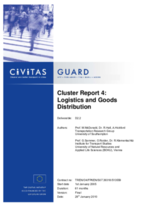New approaches to integrated planning: Kralingse Zoom
Summary
The measure was designed to demonstrate the benefits of integrated approaches to urban planning at traffic and transport nodes at three city centre locations.
Implementing sustainable mobility
The development of public areas combining several functions has been addressed in several policy documents, in particular the Rotterdam Plan for Spatial Development. This measure developed a new approach to integrated planning for three strategic transport interchanges: Alexander, Kralingse Zoom and Ahoy-Zuidplein.
The focus at the Kralingse Zoom site was on expanding the park and ride facilities with 1,470 extra parking spaces, and improving accessibility to the park and ride site from the highway. Plans were also made to revitalise the public transport interchange.
Progress
Due to new insights into the office market and legislation on external safety, the existing master plan from 2001 needed revision. A new master plan for Kralingse Zoom was therefore produced in May 2004. The development of the area was an opportunity to improve traffic flow on nearby main roads and to tackle congestion. At local level, several municipality departments, the public transport company RET and local districts cooperated on issues such as the allocation of investment and exploitation costs. A building plan was prepared for expanding the park and ride facility at Kralingse Zoom and for improving the filter lane connecting it to the highway.
Outcomes
Due to the nature of such complex projects and their impact on spatial planning issues, they are vulnerable to resistance (i.e. the “not in my backyard” attitude). In the Kralingse Zoom area, for instance, residents feared that the introduction of fees at the park and ride facility could lead to increased parking pressure in residential areas.
Cooperation between government and private partners proved to be an important driver for the acceptance of the project. However, the actual implementation of the integrated planning processes requires several years and lies well outside the scope of the TELLUS project. In general, it is not easy to assess the impact of “soft measures”: although aimed at improving traffic conditions by reducing congestion, it is not possible to relate actual impacts with the measure of integrated planning. Nevertheless, one positive impact of the measure was the fact that all stakeholders were involved in the long-term planning, contributing to smoothing the complex processes.








